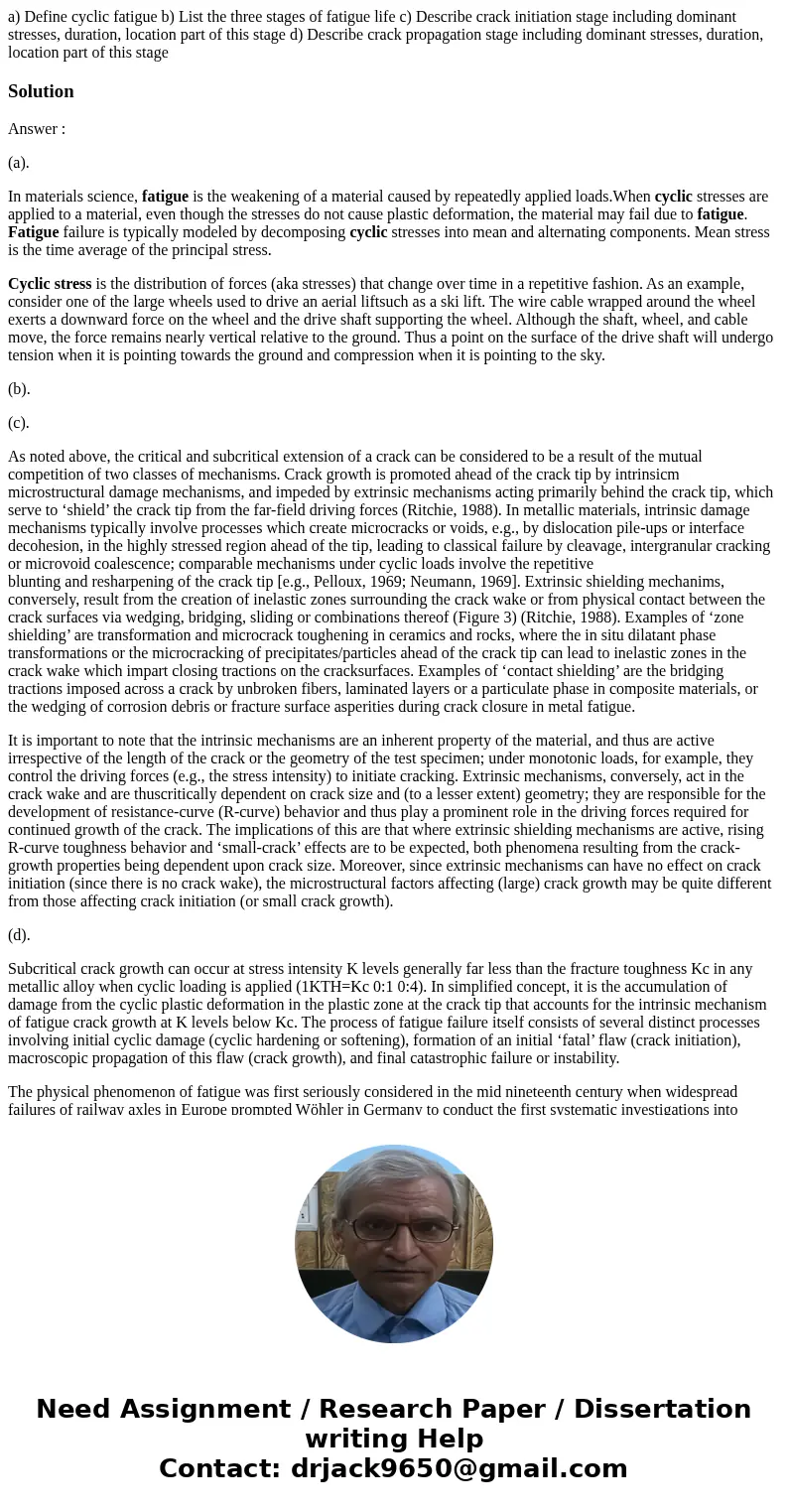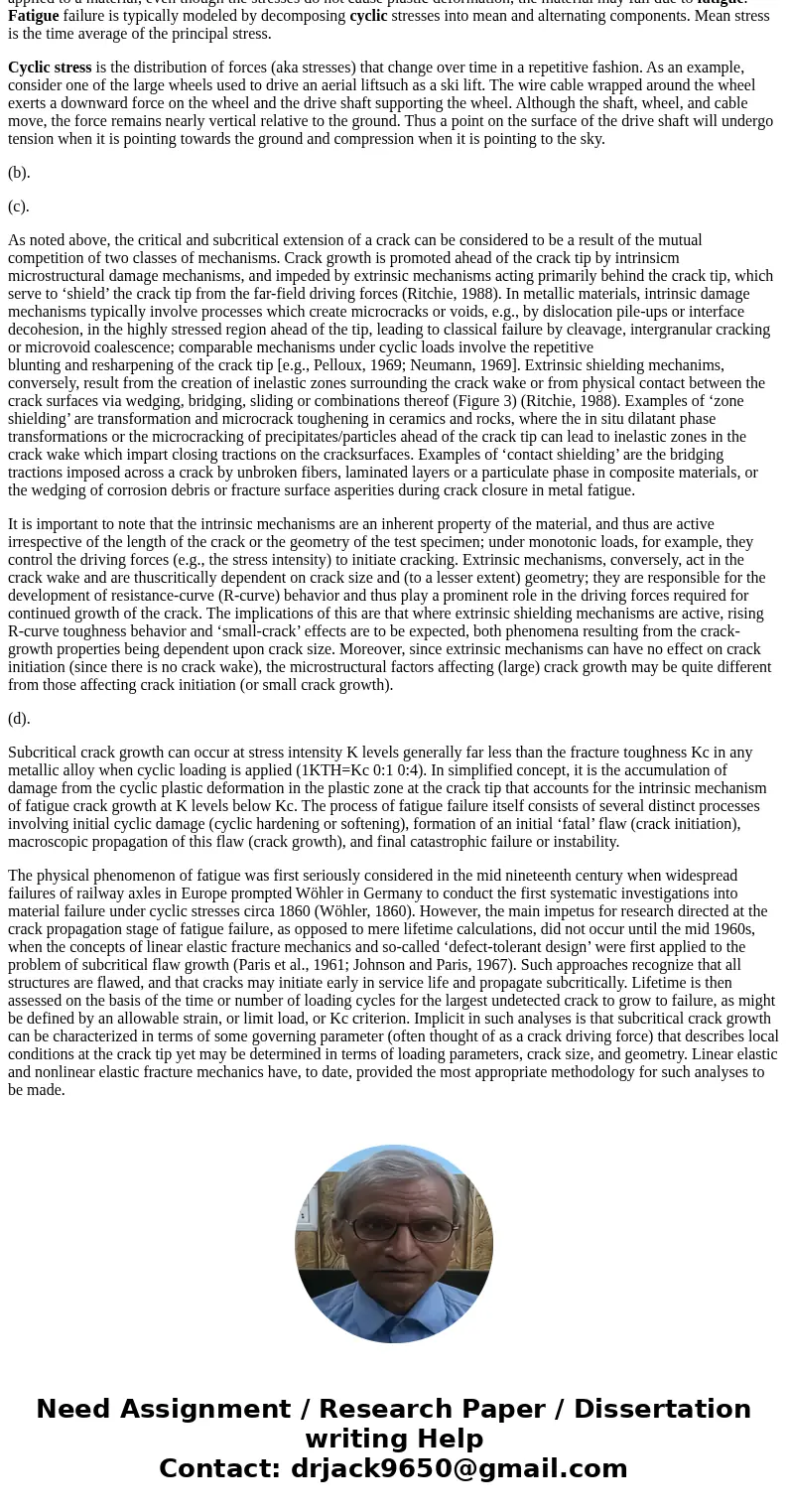a Define cyclic fatigue b List the three stages of fatigue l
a) Define cyclic fatigue b) List the three stages of fatigue life c) Describe crack initiation stage including dominant stresses, duration, location part of this stage d) Describe crack propagation stage including dominant stresses, duration, location part of this stage
Solution
Answer :
(a).
In materials science, fatigue is the weakening of a material caused by repeatedly applied loads.When cyclic stresses are applied to a material, even though the stresses do not cause plastic deformation, the material may fail due to fatigue. Fatigue failure is typically modeled by decomposing cyclic stresses into mean and alternating components. Mean stress is the time average of the principal stress.
Cyclic stress is the distribution of forces (aka stresses) that change over time in a repetitive fashion. As an example, consider one of the large wheels used to drive an aerial liftsuch as a ski lift. The wire cable wrapped around the wheel exerts a downward force on the wheel and the drive shaft supporting the wheel. Although the shaft, wheel, and cable move, the force remains nearly vertical relative to the ground. Thus a point on the surface of the drive shaft will undergo tension when it is pointing towards the ground and compression when it is pointing to the sky.
(b).
(c).
As noted above, the critical and subcritical extension of a crack can be considered to be a result of the mutual competition of two classes of mechanisms. Crack growth is promoted ahead of the crack tip by intrinsicm microstructural damage mechanisms, and impeded by extrinsic mechanisms acting primarily behind the crack tip, which serve to ‘shield’ the crack tip from the far-field driving forces (Ritchie, 1988). In metallic materials, intrinsic damage mechanisms typically involve processes which create microcracks or voids, e.g., by dislocation pile-ups or interface decohesion, in the highly stressed region ahead of the tip, leading to classical failure by cleavage, intergranular cracking or microvoid coalescence; comparable mechanisms under cyclic loads involve the repetitive
blunting and resharpening of the crack tip [e.g., Pelloux, 1969; Neumann, 1969]. Extrinsic shielding mechanims, conversely, result from the creation of inelastic zones surrounding the crack wake or from physical contact between the crack surfaces via wedging, bridging, sliding or combinations thereof (Figure 3) (Ritchie, 1988). Examples of ‘zone shielding’ are transformation and microcrack toughening in ceramics and rocks, where the in situ dilatant phase transformations or the microcracking of precipitates/particles ahead of the crack tip can lead to inelastic zones in the crack wake which impart closing tractions on the cracksurfaces. Examples of ‘contact shielding’ are the bridging tractions imposed across a crack by unbroken fibers, laminated layers or a particulate phase in composite materials, or the wedging of corrosion debris or fracture surface asperities during crack closure in metal fatigue.
It is important to note that the intrinsic mechanisms are an inherent property of the material, and thus are active irrespective of the length of the crack or the geometry of the test specimen; under monotonic loads, for example, they control the driving forces (e.g., the stress intensity) to initiate cracking. Extrinsic mechanisms, conversely, act in the crack wake and are thuscritically dependent on crack size and (to a lesser extent) geometry; they are responsible for the development of resistance-curve (R-curve) behavior and thus play a prominent role in the driving forces required for continued growth of the crack. The implications of this are that where extrinsic shielding mechanisms are active, rising R-curve toughness behavior and ‘small-crack’ effects are to be expected, both phenomena resulting from the crack-growth properties being dependent upon crack size. Moreover, since extrinsic mechanisms can have no effect on crack initiation (since there is no crack wake), the microstructural factors affecting (large) crack growth may be quite different from those affecting crack initiation (or small crack growth).
(d).
Subcritical crack growth can occur at stress intensity K levels generally far less than the fracture toughness Kc in any metallic alloy when cyclic loading is applied (1KTH=Kc 0:1 0:4). In simplified concept, it is the accumulation of damage from the cyclic plastic deformation in the plastic zone at the crack tip that accounts for the intrinsic mechanism of fatigue crack growth at K levels below Kc. The process of fatigue failure itself consists of several distinct processes involving initial cyclic damage (cyclic hardening or softening), formation of an initial ‘fatal’ flaw (crack initiation), macroscopic propagation of this flaw (crack growth), and final catastrophic failure or instability.
The physical phenomenon of fatigue was first seriously considered in the mid nineteenth century when widespread failures of railway axles in Europe prompted Wöhler in Germany to conduct the first systematic investigations into material failure under cyclic stresses circa 1860 (Wöhler, 1860). However, the main impetus for research directed at the crack propagation stage of fatigue failure, as opposed to mere lifetime calculations, did not occur until the mid 1960s, when the concepts of linear elastic fracture mechanics and so-called ‘defect-tolerant design’ were first applied to the problem of subcritical flaw growth (Paris et al., 1961; Johnson and Paris, 1967). Such approaches recognize that all structures are flawed, and that cracks may initiate early in service life and propagate subcritically. Lifetime is then assessed on the basis of the time or number of loading cycles for the largest undetected crack to grow to failure, as might be defined by an allowable strain, or limit load, or Kc criterion. Implicit in such analyses is that subcritical crack growth can be characterized in terms of some governing parameter (often thought of as a crack driving force) that describes local conditions at the crack tip yet may be determined in terms of loading parameters, crack size, and geometry. Linear elastic and nonlinear elastic fracture mechanics have, to date, provided the most appropriate methodology for such analyses to be made.


 Homework Sourse
Homework Sourse